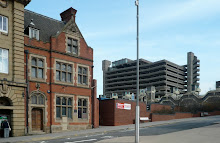Image: Joe Clark Somewhere in West Virginia, 2009, Interactive Installation: Custom Electronics in Console Housing, Micro-Controller (Arduino), Computer, Data-Projector, Projection Screen, Firewire Camera, Wood, Buckets, Hose, Pond Pump, Black Velvet and Angle-Poise Lamp (JCL0075) Courtesy of the artist and Workplace Gallery, UK
A Group Exhibition of Artists' Film
Carroll / Fletcher
17 January - 22 February 2014
Carroll / Fletcher is delighted to present Now Showing: A Group Exhibition of Artists' Film featuring work by Basel Abbas and Ruanne Abou-Rahme, Pauline Boudry / Renate Lorenz, Joe Clark, Aleksandra Domanović, Carlos Irijalba, Michael Joaquin Grey, Christoph Girardet & Matthias Müller, Oliver Pietsch and Mika Taanila. The exhibition is conceived as a journey which explores the fundamental elements constituting filmic work; each piece investigates experimental approaches towards technical processes, narrative structures and the history and culture of filmic material.
Works such as Oliver Pietsch's Tales of Us (2014) and Christoph Girardet & Matthias Müller's Meteor (2011) combine found footage in order to explore universal and psychological subject matter, and create new layers of meaning and narrative. Meteor is a montage of elements from feature films, vintage science fiction motifs and fragments of fairy tales. Beginning in a child's bedroom and ending in outer space, the various elements are assembled to trace the phantasmic journey of the child to the threshold of self-discovery and disentanglement. Pietsch's Tales of Us explores the themes of desire, love and togetherness throughout the history of cinema. Using sequences from documentary films to independent cinema through to Hollywood blockbusters, the narrative forms a chronological timeline from teenage to middle age to old age where each is free to navigate through a dreamlike state.
Michael Joaquin Grey's installation Recapitulate: Retrace, Erase, Repeat (2007), a computational software-driven film, reinvents the autonomic drawing machine to retrace and erase Goya's series of etchings, The Disasters of War, over a 24 hour period. Grey's retracing system redraws one etching every fifteen minutes, in four simultaneous yet different iterations. In retracing the etchings approximately, the work approaches, yet never reaches, the original image.
Aleksandra Domanović's Anhedonia (2009) and Mika Taanila's My Silence (2013) both manipulate feature films in order to question the relationship between sound and visual context. In the former, the audio from Woody Allen's Annie Hall (1977) is superimposed onto stock images sourced from the vast Getty Images archive. In Taanila's reductionist video and sound piece, all spoken word is removed from Louis Malle's My Dinner With André (1981), a film renowned for its multi-layered dialogue. The absence of the film's most important element leaves only gestures, facial expressions, camera movements, lighting and décor.
Berlin based duo Pauline Boudry / Renate Lorenz use a research based approach to film making, which they term 'queer archaeology', deriving their films from archival documents from marginalised subcultures that would otherwise remain unseen. To Valerie Solanas and Marilyn Monroe in Recognition of Their Desperation (2013) features six performers playing a 1970 composition by avant-garde composer Pauline Oliveros. Influenced by Valerie Solanas's 1967 feminist SCUM Manifesto, Oliveros' composition is a set of instructions which asks the performers to choose five pitches each and to play very long tones. The composition insists upon a "continuous circulation of power" between listening and sounding, and states that no performer becomes dominant, heightening awareness of the relationship between oneself and others. Shot in one continuous take, the film introduces the 16mm camera as an additional performer, who interacts with the other participants, whilst close up shots added through the editing process emphasise a fetishist interest in bodies, instruments and costumes.
From experimental technological methods to a physical approach to analogue means, and from an investigation into sociological and geopolitical themes to a more formal approach to the mechanisms of construction of an image, the spectrum of films in the exhibition create a poetic discourse into the current filmic language.
Carroll / Fletcher
56 - 57 Eastcastle Street
London W1W 8EQ






